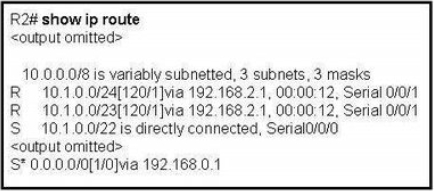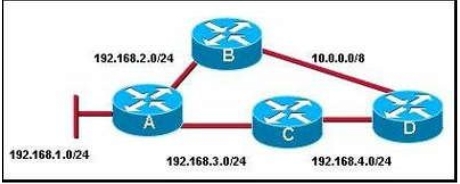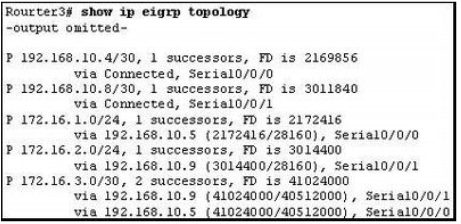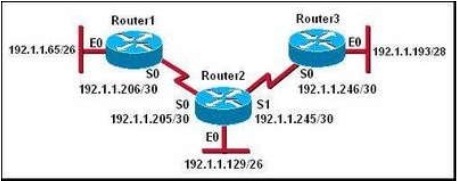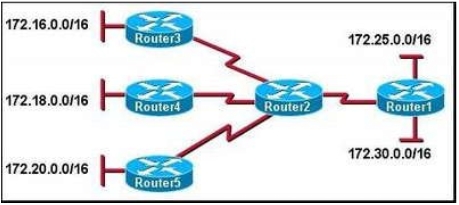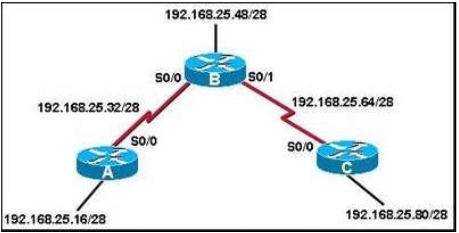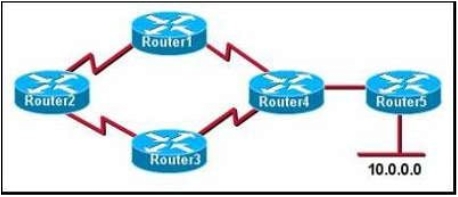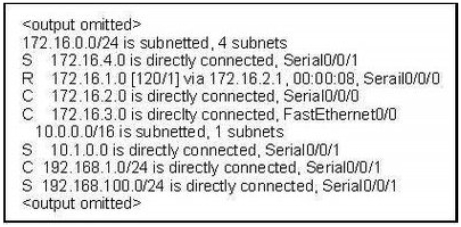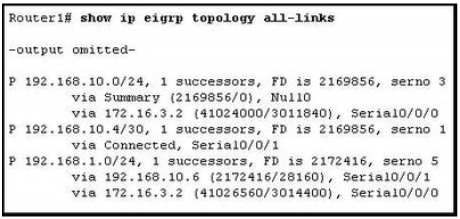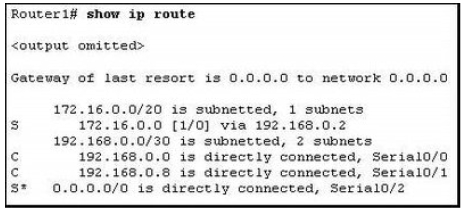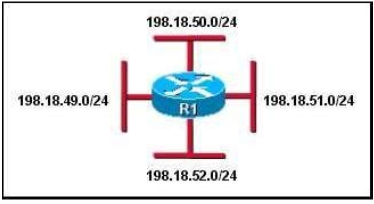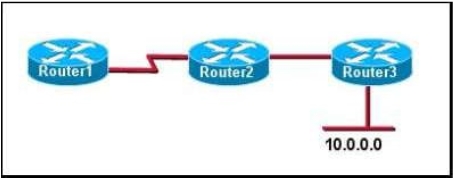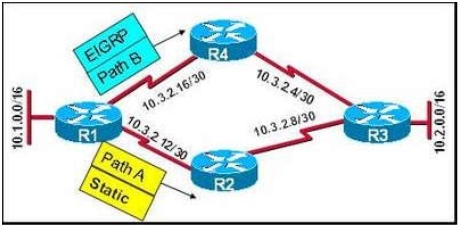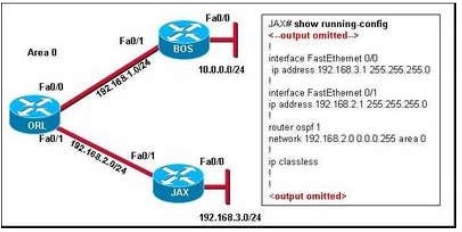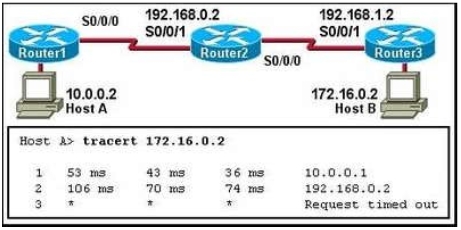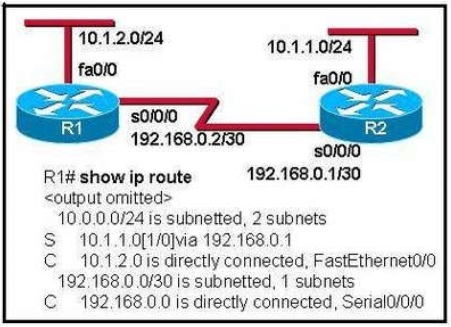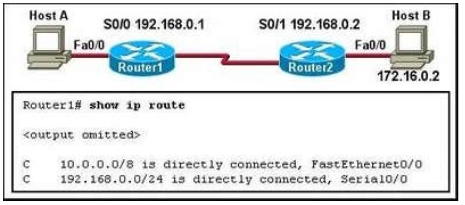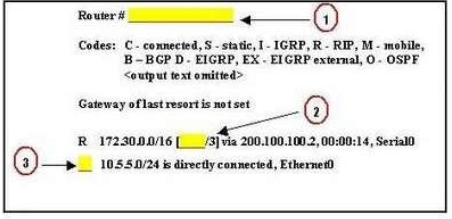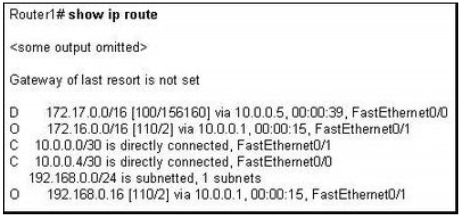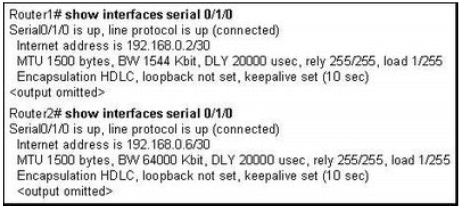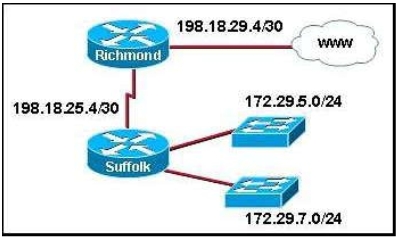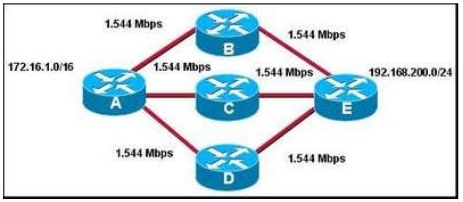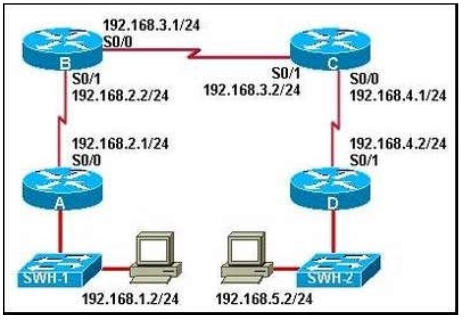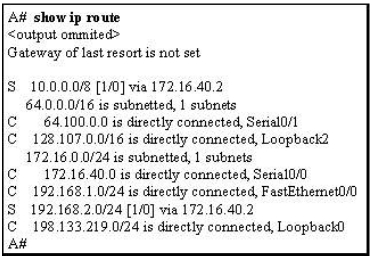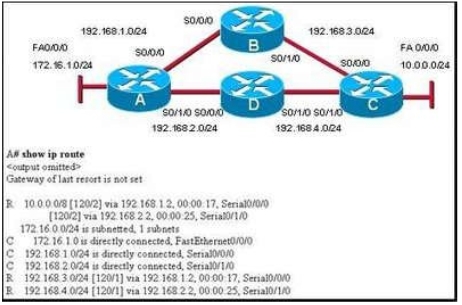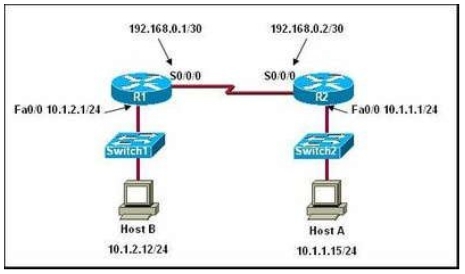CCNA Routing Protocols & Concepts Quiz
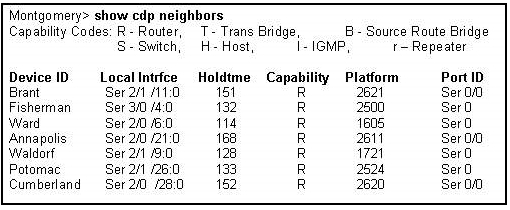
In this quiz brought to you by the Cisco Certified Network Associate, we’ll focus on a wildly important topic within the study of networking – routing! What do you know about the protocols and concepts concerned with the topic? You tell us in this quiz! Good luck!
- 1.
Which two statements are true regarding link-state routing protocols? (Choose two.)
- A.
They do not work well in networks that require special heirarchical designs.
- B.
They are aware of the complete network topology.
- C.
They pass their entire routing tables to their directly connected neighbors only.
- D.
They offer rapid convergence times in large networks.
- E.
They do not include subnet masks in their routing updates.
Correct Answer(s)
B. They are aware of the complete network topology.
D. They offer rapid convergence times in large networks.Explanation
Link-state routing protocols are aware of the complete network topology, meaning they have knowledge of all the routers and links in the network. This allows them to make more informed routing decisions based on the most up-to-date information. Additionally, link-state routing protocols offer rapid convergence times in large networks, meaning they can quickly adapt to changes in the network and update their routing tables accordingly.Rate this question:
-
- 2.
Which three statements about routing protocols are true? (Choose three.)
- A.
OSPF elects designated routers on multiaccess links.
- B.
RIP does not support classless routing.
- C.
EIGRP supports unequal cost load balancing.
- D.
EIGRP uses broadcast traffic to establish adjacencies with its neighbors.
- E.
RIP does not advertise a route beyond a hop count of 15.
Correct Answer(s)
A. OSPF elects designated routers on multiaccess links.
C. EIGRP supports unequal cost load balancing.
E. RIP does not advertise a route beyond a hop count of 15.Explanation
OSPF elects designated routers on multiaccess links. This means that in a network with multiple routers connected to a common link, OSPF will elect one router as the designated router (DR) and another as the backup designated router (BDR) to handle the routing updates for that link.
EIGRP supports unequal cost load balancing. This means that EIGRP can distribute traffic across multiple paths with different costs, allowing for more efficient use of network resources and better load balancing.
RIP does not advertise a route beyond a hop count of 15. This means that RIP, a distance vector routing protocol, will not advertise routes that are more than 15 hops away. This limitation can impact the scalability of RIP in larger networks.Rate this question:
-
- 3.
What does RIP use to reduce convergence time in a larger network?
- A.
It reduces the update timer to 15 seconds if there are more then 10 routes.
- B.
It uses triggered updates to announce network changes if they happen in between the periodic updates.
- C.
It uses random pings to detect if a pathway is down and therefore is preemptive on finding networks that are down.
- D.
It uses multicast instead of broadcast to send routing updates.
Correct Answer
B. It uses triggered updates to announce network changes if they happen in between the periodic updates.Explanation
RIP uses triggered updates to announce network changes if they happen in between the periodic updates. This helps to reduce convergence time in a larger network by quickly informing routers about any changes in the network topology. Instead of waiting for the next periodic update, routers immediately send triggered updates to inform other routers about the changes. This allows for faster convergence and ensures that all routers have the most up-to-date information about the network.Rate this question:
-
- 4.
What can be determined from the output shown in the exhibit? (Choose two.)
- A.
Annapolis is a 2611 router that is connected to the S0/0 interface of the Montgomery router.
- B.
All of the routers are connected to Montgomery through an Ethernet switch.
- C.
Montgomery has Layer 2 connectivity with Cumberland.
- D.
Layer 3 connectivity is operational for all of the devices listed in the Device ID column.
- E.
Brant, Fisherman, and Potomac are directly connected to Montgomery.
Correct Answer(s)
C. Montgomery has Layer 2 connectivity with Cumberland.
E. Brant, Fisherman, and Potomac are directly connected to Montgomery.Explanation
From the output shown in the exhibit, it can be determined that Montgomery has Layer 2 connectivity with Cumberland. This can be inferred from the fact that Cumberland is listed as a directly connected device to Montgomery. Additionally, it can be determined that Brant, Fisherman, and Potomac are directly connected to Montgomery, as they are also listed as directly connected devices to Montgomery in the exhibit.Rate this question:
-
- 5.
Refer to the exhibit. The results of the show ip route command are displayed in the graphic for Router R2. Which route will be selected for a packet with a destination address of 10.1.4.1?
- A.
Static route to 10.1.0.0/22
- B.
RIP route to 10.1.0.0/23
- C.
RIP route to 10.1.0.0/24
- D.
0.0.0.0/0 via 192.168.0.1
Correct Answer
D. 0.0.0.0/0 via 192.168.0.1Explanation
The route that will be selected for a packet with a destination address of 10.1.4.1 is 0.0.0.0/0 via 192.168.0.1. This is because the destination address falls outside of the specific subnets mentioned in the other routes. The 0.0.0.0/0 route is a default route, which means it will be used when there is no specific route available for the destination network. In this case, since there are no specific routes for the destination address 10.1.4.1, the default route will be chosen. It specifies that any traffic with an unknown destination should be sent to the next hop IP address 192.168.0.1.Rate this question:
-
- 6.
Refer to the exhibit. All router interfaces are configured with an IP address and are operational. If no routing protocols or static routes are configured, what information will be included in the show ip route command output for router A?
- A.
All of the 192.168.x.0 networks will be in the routing table.
- B.
Routes to networks 192.168.1.0/24, 192.168.2.0/24, and 192.168.3.0/24 will be in the routing table.
- C.
The routing table will be empty because routes and dynamic routes have not been configured.
- D.
A default route is automatically installed in the routing table to allow connectivity between the networks.
Correct Answer
B. Routes to networks 192.168.1.0/24, 192.168.2.0/24, and 192.168.3.0/24 will be in the routing table.Explanation
If no routing protocols or static routes are configured, the router will only have knowledge of directly connected networks. In this case, the router interfaces are configured with IP addresses in the 192.168.x.0 range. Therefore, the only networks that will be included in the routing table are 192.168.1.0/24, 192.168.2.0/24, and 192.168.3.0/24.Rate this question:
-
- 7.
Which of the following should be considered when troubleshooting a problem with the establishment of neighbor relationships between OSPF routers? (Choose three.)
- A.
OSPF interval timers mismatch
- B.
Gateway of last resort not redistributed
- C.
Interface network type mismatch
- D.
No loopback interface configured
- E.
Inconsistent authentication configuration
Correct Answer(s)
A. OSPF interval timers mismatch
C. Interface network type mismatch
E. Inconsistent authentication configurationExplanation
When troubleshooting a problem with the establishment of neighbor relationships between OSPF routers, there are three factors that should be considered. First, an OSPF interval timers mismatch can cause issues, as the routers may not be able to synchronize their timers properly. Second, an interface network type mismatch can prevent neighbor relationships from forming, as the routers need to be configured with the same network type. Lastly, inconsistent authentication configuration can also hinder the establishment of neighbor relationships, as the routers may not be able to authenticate each other properly.Rate this question:
-
- 8.
Refer to the exhibit. A network administrator is trying to figure out why BOS does not have the 10.0.0.0/24 network in its routing table. All routers are configured for OSPF in area 0. The links between the routers are operational and the administrator is able to ping between all router interfaces. What is a logical next step that the network administrator should take to troubleshoot the problem?
- A.
Reboot the routers.
- B.
Change the OSPF process ID on all of the routers to 0.
- C.
Check to see if the cable is loose between BOS and JAX.
- D.
Check to see if CDP packets are passing between the routers.
- E.
Use show and debug commands to determine if hellos are propagating.
Correct Answer
E. Use show and debug commands to determine if hellos are propagating.Explanation
The network administrator should use show and debug commands to determine if hellos are propagating. This step will help the administrator to verify if OSPF hellos are being sent and received correctly between the routers. By analyzing the output of these commands, the administrator can identify any issues with the OSPF communication and determine if hellos are reaching BOS. This will provide valuable information to troubleshoot and resolve the problem of the missing network in BOS's routing table.Rate this question:
-
- 9.
Refer to the exhibit. What two statements are true based on the output shown? (Choose two.) The reported distance to network 172.16.1.0 is 2172416
- A.
192.168.10.5 and 192.168.10.9 are feasible successors
- B.
Neighbors 192.168.10.9 and 192.168.10.5 have auto summary disabled
- C.
Router 3 is load balancing traffic to the 172.16.3.0 network across its serial interfaces
- D.
All interfaces shown on Router3 are in the passive state and will not send EIGRP advertisements
Correct Answer(s)
B. Neighbors 192.168.10.9 and 192.168.10.5 have auto summary disabled
C. Router 3 is load balancing traffic to the 172.16.3.0 network across its serial interfacesExplanation
The first statement is true because the output shows that the reported distance to network 172.16.1.0 is 2172416. The second statement is true because the output indicates that neighbors 192.168.10.9 and 192.168.10.5 have auto summary disabled.Rate this question:
-
- 10.
The network shown in the diagram is having problems routing traffic. It is suspected that the problem is with the addressing scheme. What is the problem with the addressing used in the topology?
- A.
The address assigned to the Ethernet0 interface of Router1 is a broadcast address for that subnetwork.
- B.
The subnetwork configured on the serial link between Router1 and Router2 overlaps with the subnetwork assigned to Ethernet0 of Router3.
- C.
The subnetwork assigned to the Serial0 interface of Router1 is on a different subnetwork from the address for Serial0 of Router2.
- D.
The subnetwork assigned to Ethernet0 of Router2 overlaps with the subnetwork assigned to Ethernet0 of Router3.
Correct Answer
B. The subnetwork configured on the serial link between Router1 and Router2 overlaps with the subnetwork assigned to Ethernet0 of Router3.Explanation
The problem with the addressing used in the topology is that the subnetwork configured on the serial link between Router1 and Router2 overlaps with the subnetwork assigned to Ethernet0 of Router3. This can cause conflicts and confusion in routing traffic between these devices as they are using the same address range.Rate this question:
-
- 11.
What is the function of the OSPF LSU packet?
- A.
Used to confirm receipt of certain types of OSPF packets
- B.
Used to establish and maintain adjacency with other OSPF routers
- C.
Used to request more information about any entry in the BDR
- D.
Used to announce new OSPF information and to reply to certain types of requests
Correct Answer
D. Used to announce new OSPF information and to reply to certain types of requestsExplanation
The OSPF LSU packet is used to announce new OSPF information and to reply to certain types of requests. This packet is responsible for distributing routing information and updating the OSPF database within the network. It is used to inform other OSPF routers about changes in the network, such as new routes or topology modifications. Additionally, the LSU packet can also reply to specific requests for information from other routers. Overall, the LSU packet plays a crucial role in maintaining an accurate and up-to-date OSPF network.Rate this question:
-
- 12.
Which of the following are primary functions of a router? (Choose two.)
- A.
Packet switching
- B.
Microsegmentation
- C.
Domain name resolution
- D.
Path selection
- E.
Flow control
Correct Answer(s)
A. Packet switching
D. Path selectionExplanation
A router's primary functions include packet switching and path selection. Packet switching refers to the process of receiving data packets from one network and then forwarding them to the appropriate network. Path selection involves choosing the most efficient path for data packets to travel through a network, considering factors such as network congestion and reliability. These two functions are essential for routers to effectively and efficiently route data packets between networks.Rate this question:
-
- 13.
Refer to the exhibit. What summary address can Router2 advertise to Router1 to reach the three networks on Routers 3, 4, and 5 without advertising any public address space or overlapping the networks on Router1?
- A.
172.16.0.0/8
- B.
172.16.0.0/10
- C.
172.16.0.0/13
- D.
172.16.0.0/20
- E.
172.16.0.0/24
Correct Answer
C. 172.16.0.0/13Explanation
Router2 can advertise the summary address 172.16.0.0/13 to Router1 in order to reach the three networks on Routers 3, 4, and 5. This summary address includes all the networks within the range of 172.16.0.0 to 172.23.255.255, without overlapping with any networks on Router1 and without advertising any public address space.Rate this question:
-
- 14.
What is the first step OSPF and IS-IS routers take in building a shortest path first database?
- A.
Learn about directly connected networks
- B.
Send hello to discover neighbors and form adjacencies
- C.
Choose successors and feasible successors to populate the topology table
- D.
Flood LSPs to all neighbors informing them of all known networks and their link states
Correct Answer
A. Learn about directly connected networksExplanation
The first step OSPF and IS-IS routers take in building a shortest path first database is to learn about directly connected networks. This means that the routers gather information about the networks that are directly connected to them, such as the network addresses and the link states. This information is then used to determine the shortest path to reach different networks in the network topology.Rate this question:
-
- 15.
Which three statements describe the operation of routing with EIGRP? (Choose three.)
- A.
As new neighbors are discovered, entries are placed in a neighbor table.
- B.
If the feasible successor has a higher advertised cost than the current successor route, then it becomes the primary route.
- C.
If hello packets are not received within the hold time, DUAL must recalculate the topology.
- D.
The reported distance is the distance to a destination as advertised by a neighbor.
- E.
EIGRP maintains full knowledge of the network topology in the topology table and exchanges full routing information with neighboring routers in every update. EIGRP builds one routing table that contains routes for all configured routed protocols.
Correct Answer(s)
A. As new neighbors are discovered, entries are placed in a neighbor table.
C. If hello packets are not received within the hold time, DUAL must recalculate the topology.
D. The reported distance is the distance to a destination as advertised by a neighbor.Explanation
EIGRP uses a neighbor table to keep track of newly discovered neighbors. If hello packets are not received within the hold time, DUAL (Diffusing Update Algorithm) recalculates the network topology. The reported distance represents the distance to a destination as advertised by a neighboring router.Rate this question:
-
- 16.
A network administrator has configured a default route on Router_A but it is not being shared with adjacent Router_B and the other routers in the OSPF area. Which command will save the administrator the time and trouble of configuring this default route on Router_B and all of the other routers in the OSPF area?
- A.
Router_A(config-router)# ospf redistribute default-route
- B.
Router_B(config-router)# ospf redistribute default-route
- C.
Router_A(config-router)# default-information originate
- D.
Router_B(config-router)# default-information originate
- E.
Router_B(config-router)# ip ospf update-default
Correct Answer
C. Router_A(config-router)# default-information originateExplanation
The correct answer is Router_A(config-router)# default-information originate. This command will advertise the default route from Router_A to Router_B and all other routers in the OSPF area. It saves the administrator the time and trouble of manually configuring the default route on each router separately.Rate this question:
-
- 17.
Which of the following are required when adding a network to the OSPF routing process configuration? (Choose three.)
- A.
Network address
- B.
Loopback address
- C.
Autonomous system number
- D.
Area ID
- E.
Wildcard mask
Correct Answer(s)
A. Network address
D. Area ID
E. Wildcard maskExplanation
When adding a network to the OSPF routing process configuration, three things are required. The network address is needed to specify the IP address range of the network that will be added. The area ID is necessary to determine the OSPF area in which the network will be located. Finally, the wildcard mask is required to define the range of IP addresses that will be included in the network. The loopback address and autonomous system number are not necessary for adding a network to the OSPF routing process configuration.Rate this question:
-
- 18.
A network administrator has enabled RIP on routers B and C in the network diagram. Which of the following commands will prevent RIP updates from being sent to Router A?
- A.
A(config)# router rip A(config-router)# passive-interface S0/0
- B.
B(config)# router rip B(config-router)# network 192.168.25.48 B(config-router)# network 192.168.25.64
- C.
A(config)# router rip A(config-router)# no network 192.168.25.32
- D.
B(config)# router rip B(config-router)# passive-interface S0/0
- E.
A(config)# no router rip
Correct Answer
D. B(config)# router rip B(config-router)# passive-interface S0/0Explanation
The command "B(config)# router rip B(config-router)# passive-interface S0/0" will prevent RIP updates from being sent to Router A. This command configures the interface S0/0 on Router B as a passive interface for RIP, meaning that it will not send out RIP updates on that interface.Rate this question:
-
- 19.
Which statement is true regarding routing metrics?
- A.
All routing protocols use the same metrics.
- B.
EIGRP uses bandwidth as its only metric.
- C.
Routers compare metrics to determine the best route.
- D.
The larger metric generally represents the better path.
Correct Answer
C. Routers compare metrics to determine the best route.Explanation
Routers compare metrics to determine the best route. This means that when multiple routes are available, routers analyze the metrics associated with each route to determine which one is the most optimal. The metrics can include factors such as bandwidth, delay, reliability, and cost. By comparing these metrics, routers can make informed decisions about which route to choose for forwarding packets.Rate this question:
-
- 20.
Refer to the exhibit. The network is running the RIP routing protocol. Network 10.0.0.0 goes down. Which statement is true regarding how the routers in this topology will respond to this event?
- A.
Router4 will learn about the failed route 30 seconds later in the next periodic update.
- B.
Split horizon will prevent Router4 from fowarding packets to the 10.0.0.0 network until the holddown timer expires.
- C.
Router5 immediately flushes the unreachable route from its routing table.
- D.
Router5 will send Router4 a triggered update with a metric of 16 for network 10.0.0.0.
Correct Answer
D. Router5 will send Router4 a triggered update with a metric of 16 for network 10.0.0.0.Explanation
When the network 10.0.0.0 goes down, Router5 will immediately send a triggered update to Router4 with a metric of 16 for the network 10.0.0.0. This is because in RIP, a metric of 16 indicates an unreachable route. By sending this triggered update, Router5 informs Router4 about the failure of the network 10.0.0.0 and updates its routing table accordingly.Rate this question:
-
- 21.
What command would the network administrator apply to a router that is running OSPF to advertise the entire range of addresses included in 172.16.0.0/19 in area 0?
- A.
R1(config-router)# network 172.16.0.0 0.0.0.255 area 0
- B.
R1(config-router)# network 172.16.0.0 0.0.3.255 area 0
- C.
R1(config-router)# network 172.16.0.0 0.0.15.255 area 0
- D.
R1(config-router)# network 172.16.0.0 0.0.31.255 area 0
Correct Answer
D. R1(config-router)# network 172.16.0.0 0.0.31.255 area 0Explanation
The correct answer is "R1(config-router)# network 172.16.0.0 0.0.31.255 area 0". This command is used to advertise the entire range of addresses included in the 172.16.0.0/19 subnet in area 0 of the OSPF routing protocol. The network statement specifies the network address and wildcard mask that defines the range of addresses to be advertised. In this case, the wildcard mask 0.0.31.255 covers all addresses from 172.16.0.0 to 172.16.31.255, which is the entire range of the 172.16.0.0/19 subnet.Rate this question:
-
- 22.
Refer to the exhibit. How many routes are both level 1 and qualify for use as an ultimate route?
- A.
1
- B.
2
- C.
3
- D.
4
- E.
6
Correct Answer
B. 2Explanation
Based on the given exhibit, we can see that there are two routes that are both level 1 and qualify for use as an ultimate route. The other routes either belong to level 2 or do not qualify as ultimate routes. Therefore, the correct answer is 2.Rate this question:
-
- 23.
Refer to the exhibit. What will happen if interface s0/0/1 goes down on Router1?
- A.
The Dijkstra algorithm will calculate the feasible successor.
- B.
DUAL will query neighbors for a route to network 192.168.1.0.
- C.
Neighbor 172.16.3.2 will be promoted to the feasible successor.
- D.
Traffic destined to the 192.168.1.0 network will be dropped immediately due to lack of a feasible successor.
Correct Answer
B. DUAL will query neighbors for a route to network 192.168.1.0.Explanation
If interface s0/0/1 goes down on Router1, DUAL (Diffusing Update Algorithm) will query its neighbors for an alternative route to the network 192.168.1.0. This is because DUAL is the algorithm used by Cisco's EIGRP (Enhanced Interior Gateway Routing Protocol) to calculate the best path to a destination network. When a link failure occurs, DUAL will query its neighbors to find a new path to the network, ensuring that traffic can still be routed correctly. Therefore, the correct answer is that DUAL will query neighbors for a route to network 192.168.1.0.Rate this question:
-
- 24.
Refer to the exhibit. The network administrator issues the command no ip classless on Router1. What forwarding action will take place on a packet that is received by Router1 and is destined for host 192.168.0.26?
- A.
The packet will be dropped.
- B.
The packet will be forwarded to the gateway of last resort.
- C.
The packet will match the 192.168.0.0 network and be forwarded out Serial 0/0.
- D.
The packet will most closely match the 192.168.0.8 subnet and be forwarded out Serial 0/1.
Correct Answer
A. The packet will be dropped.Explanation
When the command "no ip classless" is issued on Router1, it means that the router will not perform any classless routing. In this scenario, the packet that is received by Router1 and is destined for host 192.168.0.26 will not be able to find a matching route in the routing table. As a result, the packet will be dropped and not forwarded to any destination.Rate this question:
-
- 25.
Which three statements are true regarding the encapsulation and de-encapsulation of packets when traveling through a router? (Choose three.)
- A.
The router modifies the TTL field, decrementing it by one.
- B.
The router changes the source IP to the IP of the exit interface.
- C.
The router maintains the same source and destination IP.
- D.
The router changes the source physical address to the physical address of the exit interface.
- E.
The router sends the packet out all other interfaces, besides the one it entered the router on.
Correct Answer(s)
A. The router modifies the TTL field, decrementing it by one.
C. The router maintains the same source and destination IP.
D. The router changes the source physical address to the physical address of the exit interface.Explanation
When packets travel through a router, the TTL (Time to Live) field is modified by decrementing it by one. This is done to prevent packets from circulating indefinitely in the network. The router also maintains the same source and destination IP addresses, as these are essential for proper packet routing. Additionally, the router changes the source physical address to the physical address of the exit interface. This is necessary for the recipient to identify the correct source of the packet.Rate this question:
-
- 26.
Refer to the exhibit. What is the most efficient summarization of the routes attached to router R1?
- A.
198.18.0.0/16
- B.
198.18.48.0/21
- C.
198.18.32.0/22
- D.
198.18.48.0/23
- E.
198.18.52.0/22
Correct Answer
B. 198.18.48.0/21Explanation
The most efficient summarization of the routes attached to router R1 is 198.18.48.0/21. This is because it covers the largest range of IP addresses among the given routes while also minimizing the number of routes required for routing decisions.Rate this question:
-
- 27.
What are two tasks that must be completed before two routers can use OSPF to form a neighbor adjacency? (Choose two.)
- A.
The routers must elect a designated router.
- B.
The routers must agree on the network type.
- C.
The routers must use the same dead interval.
- D.
The routers must exchange link state requests.
- E.
The routers must exchange database description packets.
Correct Answer(s)
B. The routers must agree on the network type.
C. The routers must use the same dead interval.Explanation
Before two routers can use OSPF to form a neighbor adjacency, they must agree on the network type. This is important because OSPF supports different network types such as broadcast, point-to-point, and non-broadcast multi-access. The routers must also use the same dead interval, which is the time interval after which a router considers a neighbor to be down if it does not receive any OSPF hello packets. This ensures that both routers have the same understanding of when a neighbor is considered to be unreachable.Rate this question:
-
- 28.
Refer to the exhibit. The network is using the RIPv2 routing protocol. If network 10.0.0.0 goes down, what mechanism will prevent Router1 from advertising false routing information back to Router2?
- A.
Triggered updates
- B.
Poison reverse
- C.
Holddown timers
- D.
Split horizon
Correct Answer
D. Split horizonExplanation
Split horizon is a mechanism used in distance-vector routing protocols, such as RIPv2, to prevent the advertisement of false routing information. In this case, if network 10.0.0.0 goes down, split horizon will prevent Router1 from advertising this information back to Router2. Split horizon ensures that a router does not advertise a route back to the same interface from which it was learned, thus avoiding loops in the network. By not advertising false routing information, split horizon helps maintain a stable and accurate routing table.Rate this question:
-
- 29.
Refer to the exhibit. R1 knows two routes, Path A and Path B, to the Ethernet network attached to R3. R1 learned Path A to network 10.2.0.0/16 from a static route and Path B to network 10.2.0.0/16 from EIGRP. Which route will R1 install in its routing table?
- A.
Both routes are installed and load balancing occurs across both paths.
- B.
The route via Path B is installed because the EIGRP route has the best metric to network 10.2.0.0/16.
- C.
The route via Path A is installed because the static route has the best metric to network 10.2.0.0/16.
- D.
The route via Path B is installed because the EIGRP route has the lowest administrative distance to network 10.2.0.0/16.
- E.
The route via Path A is installed because the static route has the lowest administrative distance to network 10.2.0.0/16.
Correct Answer
E. The route via Path A is installed because the static route has the lowest administrative distance to network 10.2.0.0/16.Explanation
The correct answer is that the route via Path A is installed because the static route has the lowest administrative distance to network 10.2.0.0/16. Administrative distance is a value assigned to different routing protocols, indicating their trustworthiness or priority. In this case, the static route has a lower administrative distance than EIGRP, so it is preferred and installed in the routing table.Rate this question:
-
- 30.
Refer to the exhibit. Hosts on the BOS Fa0/0 LAN are able to ping the Fa0/1 interface on the JAX router and all interfaces on the BOS and ORL routers. Why would hosts from the 10.0.0.0/24 network not be able to ping hosts on the Fa0/0 LAN of the JAX router?
- A.
The JAX router has the wrong process ID.
- B.
The JAX router needs the network 10.0.0.0 0.0.0.255 area 0 command.
- C.
The JAX router needs the network 192.168.3.0 0.0.0.255 area 0 command.
- D.
The BOS router needs the network 192.168.3.0 0.0.0.255 area 0 command.
Correct Answer
C. The JAX router needs the network 192.168.3.0 0.0.0.255 area 0 command.Explanation
The reason why hosts from the 10.0.0.0/24 network would not be able to ping hosts on the Fa0/0 LAN of the JAX router is because the JAX router does not have the network 192.168.3.0 0.0.0.255 area 0 command configured. This command is necessary to advertise the 192.168.3.0 network to other routers in the OSPF area. Without this command, the JAX router will not include the Fa0/0 interface in its OSPF advertisements, preventing hosts from the 10.0.0.0/24 network from reaching the Fa0/0 LAN.Rate this question:
-
- 31.
What is the purpose of the TTL field within an IP packet header?
- A.
Clears an unreachable route from the routing table after the invalid timer expires prevents regular update messages from inappropriately reinstating a route that may have gone bad
- B.
Removes an unreachable route from the routing table after the flush timer expires
- C.
Limits the period of time or number of hops a packet can traverse through the network before it should be discarded
- D.
Used to mark the route as unreachable in a routing update that is sent to other routers
Correct Answer
C. Limits the period of time or number of hops a packet can traverse through the network before it should be discardedExplanation
The TTL (Time to Live) field within an IP packet header is used to limit the period of time or number of hops a packet can traverse through the network before it should be discarded. This helps prevent packets from circulating indefinitely in the network and ensures efficient routing. Once the TTL value reaches zero, the packet is discarded by the router. This mechanism helps to prevent congestion and ensures that packets do not consume excessive network resources.Rate this question:
-
- 32.
Refer to the exhibit. The network administrator is testing network connectivity by issuing the tracert command from host A to host B. Given the exhibited output on host A, what are two possible routing table issues on the network? (Choose two.)
- A.
Router1 is missing a route to the 172.16.0.0 network
- B.
Router1 is missing a route to the 192.168.1.0 network
- C.
Router2 is missing a route to the 172.16.0.0 network
- D.
Router3 is missing a route to the 10.0.0.0 network
- E.
Router3 is missing a route to the 192.168.0.0 network
Correct Answer(s)
C. Router2 is missing a route to the 172.16.0.0 network
D. Router3 is missing a route to the 10.0.0.0 networkExplanation
Based on the exhibited output, the tracert command shows that there is a failure in reaching the 172.16.0.0 network and the 10.0.0.0 network. This indicates that there might be routing table issues on Router2 and Router3. Router2 is missing a route to the 172.16.0.0 network, and Router3 is missing a route to the 10.0.0.0 network.Rate this question:
-
- 33.
Refer to the exhibit. Which statement is true concerning the routing configuration?
- A.
Using dynamic routing instead of static routing would have required fewer configuration steps.
- B.
The 10.1.1.0/24 and 10.1.2.0/24 routes have adjacent boudaries and should be summarized.
- C.
The static route will not work correctly.
- D.
Packets routed to the R2 ethernet interface require two routing table lookups.
Correct Answer
D. Packets routed to the R2 ethernet interface require two routing table lookups.Explanation
The given correct answer states that packets routed to the R2 ethernet interface require two routing table lookups. This means that when a packet is sent to the R2 ethernet interface, the router will need to perform two separate lookups in its routing table to determine the appropriate next hop for the packet. This can potentially slow down the routing process and increase latency for these packets compared to other routes that only require a single lookup.Rate this question:
-
- 34.
Refer to the exhibit. Pings are failing between HostA and HostB. The network administrator discovers that Router1 does not have a route to the 172.16.0.0 network. Assuming Router2 is configured correctly, which two static routes could be configured on Router1 to enable HostA to reach network 172.16.0.0? (Choose Two)
- A.
Ip route 172.16.0.0 255.255.0.0 S0/0
- B.
Ip route 172.16.0.0 255.255.0.0 S0/1
- C.
Ip route 172.16.0.0 255.255.0.0 192.168.0.2
- D.
Ip route 192.168.0.1 172.16.0.0 255.255.0.0 S0/0
- E.
Ip route 192.168.0.1 172.16.0.0 255.255.0.0 S0/1
Correct Answer(s)
C. Ip route 172.16.0.0 255.255.0.0 192.168.0.2
D. Ip route 192.168.0.1 172.16.0.0 255.255.0.0 S0/0Explanation
The correct answer is "ip route 172.16.0.0 255.255.0.0 192.168.0.2" and "ip route 192.168.0.1 172.16.0.0 255.255.0.0 S0/0". These routes specify the next-hop IP address or interface for the 172.16.0.0 network. The first route directs traffic to the next-hop IP address 192.168.0.2, while the second route directs traffic to the S0/0 interface with the IP address 192.168.0.1. By configuring these routes on Router1, HostA will be able to reach the 172.16.0.0 network.Rate this question:
-
- 35.
A router has learned about a network through static and dynamic routing processes. Which route will be used to reach network 192.168.168.0?
- A.
D 192.168.168.0/24 [90/2195456] via 192.168.200.1, 00:00:09, Ethernet0
- B.
O 192.168.168.0/24 [110/1012] via 192.168.200.1, 00:00:22, Ethernet0
- C.
R 192.168.168.0/24 [120/1] via 192.168.200.1, 00:00:17, Ethernet0
- D.
S 192.168.168.0/24 [1/0] via 192.168.200.1
Correct Answer
D. S 192.168.168.0/24 [1/0] via 192.168.200.1Explanation
The answer is "S 192.168.168.0/24 [1/0] via 192.168.200.1". In this case, the "S" stands for a static route. A static route is a manually configured route that does not change unless explicitly modified by an administrator. The other routes in the options are dynamic routes. Dynamic routes are learned and updated automatically by the routing protocol. Since the static route has the lowest administrative distance of 1, it will be preferred over the dynamic routes with higher administrative distances. Therefore, the router will use the static route to reach network 192.168.168.0.Rate this question:
-
- 36.
What are three features of CDP? (Choose three.)
- A.
Tests Layer 2 connectivity
- B.
Provides a layer of security
- C.
Enabled by default on each interface
- D.
Used for debugging Layer 4 connectivity issues
- E.
Provides information on directly connected devices that have CDP enabled
Correct Answer(s)
A. Tests Layer 2 connectivity
C. Enabled by default on each interface
E. Provides information on directly connected devices that have CDP enabledExplanation
CDP (Cisco Discovery Protocol) is a Cisco proprietary protocol used to gather information about directly connected Cisco devices. It is enabled by default on each interface, allowing devices to automatically discover and gather information about their neighboring devices. CDP also tests Layer 2 connectivity by exchanging information such as device ID, platform, and IP address with neighboring devices. Therefore, the correct features of CDP are that it tests Layer 2 connectivity, is enabled by default on each interface, and provides information on directly connected devices that have CDP enabled.Rate this question:
-
- 37.
Refer to the exhibit. When troubleshooting a network, it is important to interpret the output of various router commands. On the basis of the exhibit, which three statements are true? (Choose three.)
- A.
The missing information for Blank 1 is the command show ip route.
- B.
The missing information for Blank 1 is the command debug ip route.
- C.
The missing information for Blank 2 is the number 120.
- D.
The missing information for Blank 3 is the letter R.
- E.
The missing information for Blank 3 is the letter C.
Correct Answer(s)
A. The missing information for Blank 1 is the command show ip route.
C. The missing information for Blank 2 is the number 120.
E. The missing information for Blank 3 is the letter C.Explanation
The exhibit suggests that the missing information for Blank 1 is the command "show ip route" because the output displayed is the result of this command. The missing information for Blank 2 is the number 120 because it is shown in the output as the administrative distance for the route. The missing information for Blank 3 is the letter C because it is shown in the output as the code for the connected route.Rate this question:
-
- 38.
Which of the following could describe the devices labeled “?” in the graphic? (Choose three.)
- A.
DCE
- B.
CSU/DSU
- C.
LAN switch
- D.
Modem
- E.
Hub
Correct Answer(s)
A. DCE
B. CSU/DSU
D. ModemExplanation
The devices labeled "?" in the graphic could be described as DCE (Data Communications Equipment), CSU/DSU (Channel Service Unit/Data Service Unit), and modem. DCE refers to the equipment that communicates with the data circuit, CSU/DSU is used for connecting a digital circuit to a network, and a modem is a device that converts digital signals to analog signals for transmission over telephone lines. These three descriptions align with the functions and characteristics of the devices labeled "?" in the graphic.Rate this question:
-
- 39.
Refer to the exhibit. Which three statements are true of the routing table for Router1? (Choose three.)
- A.
The route to network 172.16.0.0 has an AD of 156160.
- B.
The AD of EIGRP routes has been manually changed to a value other than the default value.
- C.
Router1 is running both the EIGRP and OSPF routing process.
- D.
Network 172.17.0.0 can only be reached using a default route.
- E.
No default route has been configured.
Correct Answer(s)
B. The AD of EIGRP routes has been manually changed to a value other than the default value.
C. Router1 is running both the EIGRP and OSPF routing process.
E. No default route has been configured.Explanation
The given answer states that the AD (Administrative Distance) of EIGRP routes has been manually changed to a value other than the default value. This suggests that the router is using EIGRP as one of its routing protocols and the AD for EIGRP routes has been customized.
The answer also mentions that Router1 is running both the EIGRP and OSPF routing process. This indicates that the router is using both EIGRP and OSPF as its routing protocols.
Lastly, the answer states that no default route has been configured. This means that there is no specific route defined for network 172.17.0.0, and it can only be reached using a default route.
Overall, the answer provides three true statements about the routing table for Router1.Rate this question:
-
- 40.
Refer to the exhibit. The ORL router is unable to form a neighbor relationship with the JAX router. What is a possible cause of this problem?
- A.
Router JAX has the wrong autonomous-system number.
- B.
The command network 192.168.2.0 is missing from the EIGRP configuration on the JAX router.
- C.
Automatic summarization is not disabled on the JAX router.
- D.
Router JAX has the wrong IP address on the Fa0/1 interface.
Correct Answer
B. The command network 192.168.2.0 is missing from the EIGRP configuration on the JAX router.Explanation
The possible cause of the problem is that the command "network 192.168.2.0" is missing from the EIGRP configuration on the JAX router. This command is used to include the specified network in the EIGRP routing process. Without this command, the JAX router will not advertise the 192.168.2.0 network to its neighbors, including the ORL router. As a result, the ORL router will not be able to form a neighbor relationship with the JAX router.Rate this question:
-
- 41.
Refer to the exhibit. Routers 1 and 2 are directly connected over a serial link. Pings are failing between the two routers. What change by the administrator will correct the problem?
- A.
Set the encapsulation on both routers to PPP.
- B.
Decrease the bandwidth on Serial 0/1/0 on router 2 to 1544.
- C.
Change the cable that connects the routers to a crossover cable.
- D.
Change the IP address on Serial 0/1/0 on router 2 to 192.168.0.1/30.
Correct Answer
D. Change the IP address on Serial 0/1/0 on router 2 to 192.168.0.1/30.Explanation
Changing the IP address on Serial 0/1/0 on router 2 to 192.168.0.1/30 will correct the problem because it will ensure that both routers are on the same subnet and can communicate with each other.Rate this question:
-
- 42.
The Suffolk router is directly connected to the networks shown in the graphic and has a default route that points to the Richmond router. All interfaces are active and properly addressed. However, when the workstation on network 172.29.5.0/24 sends a packet to destination address 172.29.198.5, it is discarded by the Suffolk router. What can be a reason for this result?
- A.
The ip classless command is not enabled on the Richmond router.
- B.
The route was ignored if the Richmond router did not include the 172.29.198.0/24 network in its routing updates.
- C.
The Richmond router is in a different autonomous system than the Suffolk router.
- D.
The ip subnet-zero command was not configured on the Suffolk router.
- E.
The ip classless command is not enabled on the Suffolk router.
Correct Answer
E. The ip classless command is not enabled on the Suffolk router.Explanation
The reason for the discarded packet could be that the ip classless command is not enabled on the Suffolk router. The ip classless command allows the router to forward packets to a default route even if the router does not have a specific route for the destination network. In this case, since the Suffolk router does not have a specific route for the destination network 172.29.198.0/24, and if the ip classless command is not enabled, it will discard the packet instead of forwarding it to the default route.Rate this question:
-
- 43.
When presented with multiple valid routes to a destination, what criteria does a router use to determine which routes to add to the routing table?
- A.
The router selects the routes with the best metric. All routes that have the same best metric are added to the routing table.
- B.
The router first selects routes with the lowest administrative distance. The resulting routes are then prioritized by metric and the routes with the best metric are added to the routing table.
- C.
The router selects the routes with the lowest administrative distance. All routes with the same lowest administrative distance are added to the routing table.
- D.
The router installs all routes in the routing table but uses the route with the best metric most when load balancing.
Correct Answer
B. The router first selects routes with the lowest administrative distance. The resulting routes are then prioritized by metric and the routes with the best metric are added to the routing table.Explanation
When presented with multiple valid routes to a destination, a router uses the lowest administrative distance as the first criteria to determine which routes to add to the routing table. The routes with the lowest administrative distance are then prioritized by metric, and the routes with the best metric are added to the routing table. This means that the router will prefer routes with lower administrative distance and better metrics, ensuring efficient and reliable routing.Rate this question:
-
- 44.
Refer to the exhibit. What are the effects of the exhibited commands on the router?
- A.
All passwords are encrypted.
- B.
Only Telnet sessions are encrypted.
- C.
Only the enable password is encrypted.
- D.
Only the enable password and Telnet session are encrypted.
- E.
Enable and console passwords are encrypted.
Correct Answer
C. Only the enable password is encrypted.Explanation
The exhibited commands have the effect of encrypting only the enable password on the router. This means that the enable password, which is used to gain privileged access to the router, is protected and cannot be easily deciphered if intercepted. However, the other passwords, such as the console password and Telnet session password, are not encrypted and remain vulnerable to potential security breaches.Rate this question:
-
- 45.
Refer to the exhibit. The routers in the exhibit are running the EIGRP routing protocol. What statement is true regarding how packets will travel from the 172.16.1.0/16 network to the 192.168.200.0/24 network?
- A.
The router chooses the first path that it learned and installs only that route in the routing table.
- B.
The router chooses the path with the lowest administrative distance and installs only that route in the routing table.
- C.
The router chooses the highest routing ID based on the advertised network IP addresses and installs only that route in the routing table.
- D.
The router installs all the equal cost paths in the routing table but sends packets out only one, holding the others in reserve in case the primary route goes down.
- E.
The router installs all the equal cost paths in the routing table and performs equal cost load balancing to send packets out multiple exit interfaces.
Correct Answer
E. The router installs all the equal cost paths in the routing table and performs equal cost load balancing to send packets out multiple exit interfaces.Explanation
The correct answer is that the router installs all the equal cost paths in the routing table and performs equal cost load balancing to send packets out multiple exit interfaces. This means that if there are multiple paths with the same cost to reach the destination network, the router will install all of them in its routing table and distribute the traffic across those paths to achieve load balancing. This ensures efficient utilization of network resources and improves overall network performance.Rate this question:
-
- 46.
When the show cdp neighbors command is issued from Router C, which devices will be displayed in the output?
- A.
D, SWH-2
- B.
A, B, D
- C.
SWH-1, SWH-2
- D.
B, D
- E.
A, B, D, SWH-1, SWH-2
Correct Answer
D. B, DExplanation
When the show cdp neighbors command is issued from Router C, the devices that will be displayed in the output are B and D.Rate this question:
-
- 47.
Refer to the exhibit. Packets destined to which two networks will require the router to perform a recursive lookup? (Choose two.)
- A.
10.0.0.0/8
- B.
64.100.0.0/16
- C.
128.107.0.0/16
- D.
192.168.1.0/24
- E.
192.168.2.0/24
Correct Answer(s)
A. 10.0.0.0/8
E. 192.168.2.0/24Explanation
The router will need to perform a recursive lookup for packets destined to the 10.0.0.0/8 network and the 192.168.2.0/24 network. This is because these networks are not directly connected to the router and are not in the router's routing table. Therefore, the router will need to consult its routing table and potentially query other routers to determine the next hop for these packets.Rate this question:
-
- 48.
Refer to the exhibit. Which path will traffic from the 172.16.1.0/24 network take to get to the 10.0.0.0/24 network?
- A.
ADC
- B.
ABC
- C.
It will load balance the traffic between ADC and ABC
- D.
It will send the traffic via ABC, and will use ADC as a backup path only when ABC fails.
Correct Answer
C. It will load balance the traffic between ADC and ABCExplanation
The correct answer is that the traffic from the 172.16.1.0/24 network will be load balanced between ADC and ABC. This means that the traffic will be divided between the two paths to optimize performance and distribute the load evenly.Rate this question:
-
- 49.
Refer to exhibit. A company network engineer enters the following commands in the routers: R1(config)# ip route 10.1.1.0 255.255.255.0 192.168.0.2 R2(config)# ip route 10.1.2.0 255.255.255.0 192.168.0.1 When the engineer enters the show ip route command on R1, the routing table does not display the static route to the 10.1.1.0 network. All R1 and R2 interfaces are correctly addressed per the graphic. What is a logical next step that the engineer could take in order to make the static route display in the routing table in R1?
- A.
Enter default routes in R1 and R2.
- B.
Enable the R1 and R2 serial interfaces.
- C.
Configure the static route to use an exit interface instead of a next-hop address.
- D.
Enter the copy run start command to force the router to recognize the configuration.
Correct Answer
B. Enable the R1 and R2 serial interfaces. -
- 50.
Refer to the exhibit. A packet enters Router1 with a destination IP of 172.16.28.121. Which routing table entry will be used to forward this Refer to the exhibit. A packet enters Router1 with a destination IP of 172.16.28.121. Which routing table entry will be used to forward this packet to the destination address?packet to the destination address?
- A.
172.16.0.0/16 [1/0] via 192.168.0.1
- B.
172.16.0.0/20 [1/0] via 192.168.0.9
- C.
172.16.16.0/20 [1/0] via 192.168.0.17
- D.
0.0.0.0/0 is directly connected, Serial0/0/1
Correct Answer
B. 172.16.0.0/20 [1/0] via 192.168.0.9Explanation
The correct routing table entry that will be used to forward the packet with a destination IP of 172.16.28.121 is 172.16.0.0/20 [1/0] via 192.168.0.9. This is because the destination IP falls within the range of the network address 172.16.0.0/20, and the next hop for this network is 192.168.0.9.Rate this question:
-
Quiz Review Timeline +
Our quizzes are rigorously reviewed, monitored and continuously updated by our expert board to maintain accuracy, relevance, and timeliness.
-
Current Version
-
Mar 21, 2023Quiz Edited by
ProProfs Editorial Team -
Jan 11, 2012Quiz Created by
Davider87
 Back to top
Back to top



